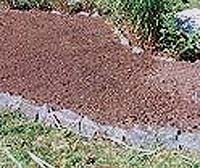RENEGADE GARDENER™
The lone voice of horticultural reason
The 2002 Renegade Gardener High Spot / Black Spot Awards
10-31-02 – What a mad and glorious gardening season we now close! The dark, bleary skies hovering above the great state of Minnesota delivered in 2002 the greatest amount of rain since precipitation records have been kept. Lawns languished thick and green, shrubs frolicked rich in leaf, annuals bloomed lush and virile, and most perennials never knew what hit ’em. Sitting on my garden bench for more than twenty minutes, powdery mildew would commence forming on the knees of my jeans.
This is the final 2002 update of the Renegade Gardener Web site (APPLAUSE). From November 1, 2002 to March 31, 2003, this site hums and hovers atop the Internet, like a Minnesota mosquito trying to decide if it should eat you where you stand, or drag you into the woods (LAUGHTER). All that’s left to be said can be conveyed easily via announcement of the 2002 Renegade Gardener High Spot/Black Spot Awards (CHEERS).
The envelopes, please … (MASS SQUEELING, GNASHING OF TEETH, SUCKING IN OF BREATH)
High Spot Award
RG Perennial of the Year: Hosta ridiculosa ‘Caligula’
Though not available to the public until next spring, the anticipation surrounding this newest wonder of the hosta world eclipses all competition. Sight unseen, advance reputation alone easily grants this plant status as the 2002 RG Perennial of the Year. I’m so excited about ‘Caligula’ I don’t trust myself to type, so will instead reprint the original press release sent last fall to all members of the garden media:
|
GERMAN NURSERY PATENTS NEW HOSTA TOO 11-13-01/Dusseldorf – Scientists at the C.E. Kreisling Nursery research and propagation lab have announced patent application for a new hosta so small it is invisible to the naked eye. The new plant, Hosta ridiculosa ‘Caligula’ will be available to the international nursery trade beginning in April of 2003.
“We are extremely excited,” said Klaus Froilech, director for the Kreisling lab. “The international demand from gardeners for dwarf varieties of plants is insatiable, particularly among hosta fanatics.” Froilech stated that ‘Caligula’ can be readily seen using most standard magnifying glasses, and described the plant as having dark green, narrow leaves fringed with yellow. “Although the yellow washes out to white if you grow the plant in too much sun,” cautioned Froilech. The plant displays a heavy profusion of lilac flowers in mid-season. “It’s exceptional in flower,” said Froilech. “Even without the magnifying glass, you can almost see them.” Similar to all new patented plant introductions, propagation is prohibited once the plant leaves the Kreisling nursery. Lawyers for the nursery are also working to institute international laws making it illegal for gardeners to claim to friends and neighbors that they have the plant in their garden, but have for the moment misplaced their magnifying glass. |
Black Spot Award
Most Ridiculous Fad: Feng Shui Gardening
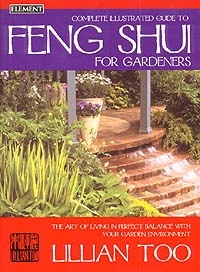 Casual perusal of the gardening section at my local bookstore unearthed five different books linking Feng Shui to garden design, two published this year. I imagine it will be five more years before this grating, gratuitous fad goes the way of the Great Lasagna Gardening Scare of the late 1980s.
Casual perusal of the gardening section at my local bookstore unearthed five different books linking Feng Shui to garden design, two published this year. I imagine it will be five more years before this grating, gratuitous fad goes the way of the Great Lasagna Gardening Scare of the late 1980s.
Strip away the Eastern mystical foofaraw, and all any Feng Shui garden design book connotes are the same common sense, practical garden design principles found in every garden design book. Groupings of an odd number look best. Paths should curve. Unsightly objects should be screened. Sick or dying plants should be replaced. Don’t plant a tree in front of your front door. Heavens, you can figure out any of these without having to harness the power of the Yang Pa Kua, the Lo Shu square, the Trigram Tui, or by enduring sleepless nights fettered by fear that your compost bin is leaking Chi.
It’s just such a crock. Sure, if your entire back yard is ringed by a tall fence, placing a gate in there somewhere is going to create better flow. But you figured that out ten years ago, when you became sick and tired of having the neighborhood kids smashing your peonies while scaling the fence, due to your yard being a nifty shortcut to the school bus stop. So you put a gate in. Feng Shui? I call it common sense.
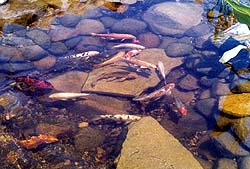 |
| Money, money, money, money |
From “Feng Shui for Gardeners” by Lillian Too: “Next examine the topography. If there are hills around you, can you detect the presence of the symbolic Feng Shui green dragon and white tiger?”
Uh, excuse me? Deer repellants, hell, next thing we’ll see are garden books on green dragon- and white tiger-proofing your garden. Or maybe a new theory of organic garden maintenance; perhaps white tigers eat deer, who knows? Here’s another tip from the book: “Chinese carp or goldfish, which are readily available and easy to keep, also activate your wealth and success Chi.”
I get it: there’s a link between carp and wealth. Of course!
High Spot Award
Best New Nursery: Uncommon Gardens
Just what we need to combat the terrible proliferation of racks upon racks of wilting red geraniums spanning the two-acre tarmacs of the Loews and Home Depots of the world: a small, independent nursery that gets it.
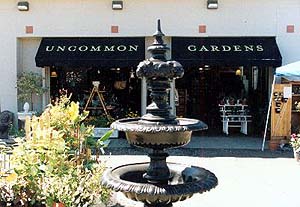 Two years ago, Peggy Poore left the big-buck world of corporate advertising to follow her passion, resulting in the launching of Uncommon Gardens. Housed smartly in a renovated service garage at 5750 Lyndale Avenue South in Minneapolis, UG features unusual annuals, perennials, shrubs, and garden accessories you don’t often find at sprawling nursery centers, or the big chains.
Two years ago, Peggy Poore left the big-buck world of corporate advertising to follow her passion, resulting in the launching of Uncommon Gardens. Housed smartly in a renovated service garage at 5750 Lyndale Avenue South in Minneapolis, UG features unusual annuals, perennials, shrubs, and garden accessories you don’t often find at sprawling nursery centers, or the big chains.
Sharp design sense is combined with horticultural savvy. A case in point: UG is one of the few local nurseries where you can find Cotinus ‘Royal Purple’ as opposed to the more commonly sold Cotinus ‘Grace.’ Over the years, ‘Royal Purple’ has been dropped by area nurseries because it suffers from winter die-back, versus the more hardy, but less aesthetically pleasing, ‘Grace.’ Except that in colder winters, ‘Royal Purple’ doesn’t die, it just dies down to the ground. It pops back in the spring with fresh, new stems and more vivid foliage color than the lumbering ‘Grace,’ and thus maintains a three- to four-foot height, perfect for the perennial bed. ‘Grace’ survives winter above ground, sure, but it proceeds to mature into a sprawling, gray, ten-foot eyesore. ‘Royal Purple’ is the more valuable variety, and the folks at UG know it.
Independent nurseries – the ones where Renegade Gardeners can find the good stuff – are getting fewer and farther between. Always buy first from independents. While it’s too late this season to buy your plants at Uncommon Gardens, you can still pop by in December to say hello, and purchase your fresh-cut Christmas tree. Then return next spring to escape the ordinary.
High Spot Award
Best New Garden Product: Soilsoup Compost Tea Maker
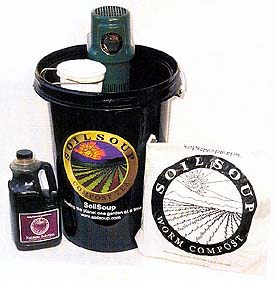 Compost tea has long proven to be a great form of fertilizer, but there’s more to it than N-P-K. Growing research points to other important benefits, such as improved disease resistance in plants, and the proliferation of healthy microorganisms in soil treated with compost tea.
Compost tea has long proven to be a great form of fertilizer, but there’s more to it than N-P-K. Growing research points to other important benefits, such as improved disease resistance in plants, and the proliferation of healthy microorganisms in soil treated with compost tea.
In the past, making compost tea has been a fairly scary enterpise – it’s not uncommon to brew a stinky tea that contains pathogens, particularly E.coli, that will actually do more harm than good. Now, manufacturers of the Soilsoup Compost Tea Maker have created a product that ensures batch after batch of perfect, powerful, benevolent compost tea. This product has the potential to revolutionize home gardening.
Soilsoup is like liquid compost. It can be watered into the soil, used as a foliar spray on lawns, or added to the compost bin to speed up the composting process. This summer I’ve been using the 6.5 gallon system kit, best for the hobby gardener, and so far haven’t been able to poke a single hole in the hoopla or hype. Check out this link to learn more: www.soilsoup.com.
Black Spot Award
Laziest Fact Checkers: Horticulture Magazine
From the December, 2002 issue of Horticulture (“Gardening at its Haughtiest”) magazine:
“To Do in the Garden: Wrap the trunks of young and thin-barked trees with commercial tree wrap to prevent sun scald damage to bark in late winter.”
No, no, no. As all good Renegade Gardeners know from reading the “Myth of the Week” feature of this site, the University of Minnesota years ago conducted and released research showing that wrapping trees with tree wrap actually makes matters worse, by trapping moisture between the wrap and trunk.
But then, Boston-based Horticulture has always firmly maintained a what-do-those-rubes-in-the-Midwest-know attitude, for as long as I can remember.
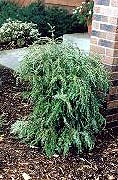 High Spot Award
High Spot Award
RG Shrub of the Year: Tsuga canadensis ‘Monler’ Common Name: Emerald Fountain Hemlock
Increasingly available to the trade and a joy in the landscape, ‘Monler’ is the perfect small evergreen for less-than-sunny spots. Maturing in the north to a manageable ten feet, it maintains a mere three-foot width, granting vertical accent without the straight, sharp, formal outline.
Regardless of what the nursery industry tells us, Arborvitae grow thin and ratty in shade, and face it, yews get boring. ‘Monler’ prefers no more than a half-day of sun while developing a weeping, sculptural habit that introduces a soft, willowy texture to the landscape.
High Spot Award
Best Product Copy/Truth in Advertising: Follett’s Watch Us Grow Fertilizing Guide
From the 23-page product guide that accompanies the Follett Company’s Watch Us Grow-brand fertilizer:
“As far as we know, Watch Us Grow can be used on most cuttings.”
Plenty good for me!
Black Spot Award
Most Unpardonable Sin: TV Show “Rebecca’s Garden” Decides to Drop Use of Latin Plant Names
Entering the new television season, producers of the syndicated television gardening show “Rebecca’s Garden” have decided that the show’s host will only use the common name for all plants mentioned, be they tree, shrub, annual, or perennial.
This trend is so typical, so sad, so scary, and so wrong. Any new visitor to this site interested in why it’s important for gardeners to learn and use proper botanical Latin plant names need only brush up on Renegade Gardening’s Fourth Tenet. But come back, for I am going to rant.
It’s unpardonable that a television show that purports to teach gardening would decide to abandon use of Latin names. The reason behind their decision? One of the producers for “Rebecca’s Garden” stated that “learning the Latin names for plants is difficult.” No, it isn’t.
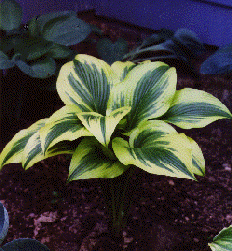 |
| Repeat after me: Plantain Lily |
Let’s pretend you are brand new to gardening and don’t know a single name, Latin or common. The first perennial you buy is a Dicentra (die-SEN-truh). The common name is Bleeding Heart. Why is learning the Latin genus harder than learning the common name? They’re both three syllables. Why not learn the plant’s true name, so you can find Dicentra in a plant catalogue or pest and disease book, rather than be told you’re not smart enough by one of the most vacuous gardening shows of all time? Memorize them both, I don’t care. In fact, you already have. Dicentra/Bleeding Heart. Took you about two seconds.
What’s so laughable about this is that the botanical Latin names for plants are often used more than their common names. What’s Rebecca going to do this season while flailing about with her Astilbe – call it “False Spirea,” the common name? How about Hosta? Are we now going to be told that a perfect plant for that shady spot is Plantain Lily? Of course not. Now the show will mix Latin and common names, further adding to the confusion. It’s the media that is dumbing-down America, not Americans.
I wrote the Fourth Tenet years ago, intending for it to be the end-all and be-all on the topic. I failed. Daniel J. Hinkley, one of the founders of Seattle, Washington’s wonderful Heronswood Nursery, has done me one better. If you would like to read a short essay that magnificently expresses why gardening involves the important, simple, and fun process of learning the Latin names for plants, click here.
High Spot Award
Best Container Planting: Man and Nature, Winnipeg River, Ontario, Canada
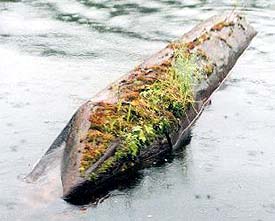 Water levels were at an all-time high this spring as I spent a few days immersed in the majesty of Northern Ontario. Early one morning I took the boat out for a quick fish, and soon came upon this magnificent container planting, bobbing silently in a wilderness bay, there for only me.
Water levels were at an all-time high this spring as I spent a few days immersed in the majesty of Northern Ontario. Early one morning I took the boat out for a quick fish, and soon came upon this magnificent container planting, bobbing silently in a wilderness bay, there for only me.
It was comprised of an airplane float long ago abandoned; settled into shore for some time somewhere upstream, it had been resigned to nature. High water had finally shaken the float loose from shore, so that it drifted slowly through the wilderness, silent, subtle, raising more questions than it answered.
What had become of the plane? How old was the float? How long does it take for metal floats to decay and bog down so they roll over bottom-side up? How long had nature spent planting it? Years? Decades? Growing lichen on steel takes time.
A light rain began to fall as I thought to snap some photos. Afterward I would be angry to discover I had my camera set in some crazy way such that none of the photos of the floating planter came out in crisp focus. But then that didn’t matter. I had seen it, had witnessed nature’s slow victory; nature, patient nature, creating, from man’s ephemeral folly, such a perfect planter, a powerful planter, an Ozymandias planter. Look on my works, ye Mighty, and despair, indeed.
It rained harder and I didn’t catch any fish, yet the morning was lovely.
Black Spot Award
Worst New Gardening Product: Womanswork® Gloves
How did female gardeners survive without them? Brand new to the market this fall, Womanswork® gardening gloves are “designed to fit the unique shape of a woman’s hand.” I thought such gloves had been available for decades: Adult Small.
Please let me know if I’m off base here, but I did a little research. I traced the outline of my eleven-year-old son’s hand on paper, then did a tracing of the hand of the eleven-year-old girl across the street. Yep, they were different – her hand was slightly longer (she’s tall).
I traced my mom’s hand, my wife’s hand, my hand, my father’s hand, my socialist neighbor Dave’s hand, even the hand of the twenty-something woman who sells me film at the photo shop down the road. I computed finger-length to overall hand-length ratios, palm-width to finger-length ratios, every ratio I could think of. And scrambling them together I couldn’t find one difference between the shape of the male hand and the shape of the female hand, except that male hands skewed a little larger all the way around. (Though not necessarily. The hands of the woman at the photo shop are huge.)
Do I sense industry avarice here? Dreaming up something unnecessary in order to make some fresh gardening industry bucks? Even the name of the product smacks a little of good ol’ boy, male design and deployment. If women were the inventors, would they have called the line Womanswork? It all smells a little fishy to me.
And that, comrades, concludes the 2002 Renegade Gardener High Spot/Black Spot Awards. I wish all Renegades a pleasant, peaceful winter respite. Feel free to e-mail this winter; I’ll be around. See you in the spring.
Don Engebretson
The Renegade Gardener
- The 2018 Renegade Gardener High Spot/Black Spot Awards January 5, 2019
- The 2017 Renegade Gardener High Spot/Black Spot Awards January 1, 2018
- The 2016 Renegade Gardener High Spot/Black Spot Awards January 1, 2017
- The 2015 Renegade Gardener High Spot/Black Spot Awards January 1, 2016
- The 2014 Renegade Gardener High Spot/Black Spot Awards January 7, 2015
- The 2013 Renegade Gardener High Spot/Black Spot Awards January 1, 2014
- The 2012 Renegade Gardener High Spot/Black Spot Awards January 4, 2013
- The 2011 Renegade Gardener High Spot/Black Spot Awards January 1, 2012
- The 2010 Renegade Gardener High Spot/Black Spot Awards January 1, 2011
- The 2009 Renegade Gardener High Spot/Black Spot Awards January 1, 2010
- The 2008 Renegade Gardener High Spot/Black Spot Awards January 1, 2009
- The 2007 Renegade Gardener High Spot/Black Spot Awards January 3, 2008
- The 2006 Renegade Gardener High Spot/Black Spot Awards December 20, 2006
- The 2005 Renegade Gardener High Spot/Black Spot Awards December 9, 2005
- The 2004 Renegade Gardener High Spot/Black Spot Awards January 1, 2005
- The 2003 Renegade Gardener High Spot/Black Spot Awards November 19, 2003
- The 2002 Renegade Gardener High Spot/Black Spot Awards October 31, 2002
- The 2001 Renegade Gardener High Spot/Black Spot Awards October 16, 2001
- The 2000 Renegade Gardener High Spot/Black Spot Awards October 20, 2000
